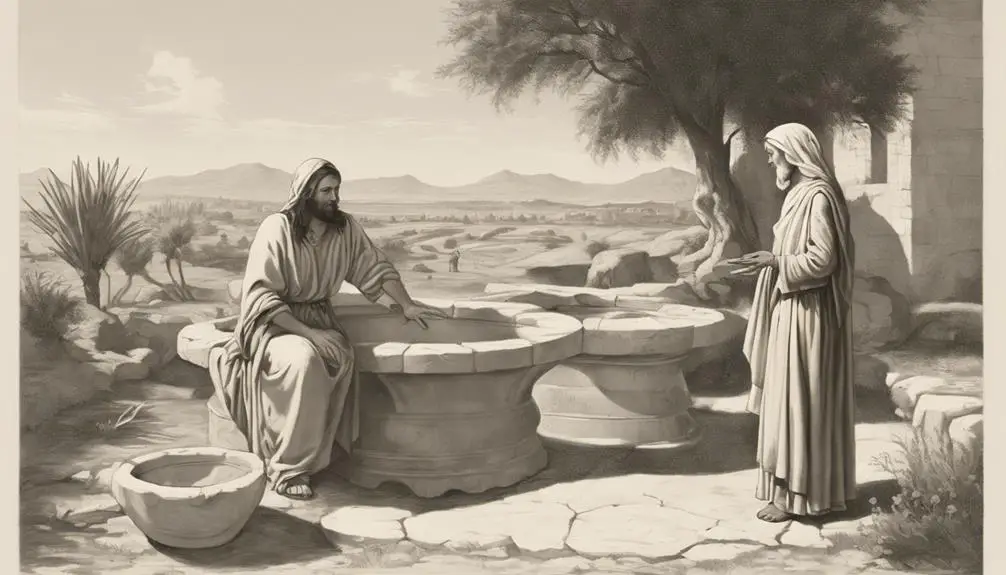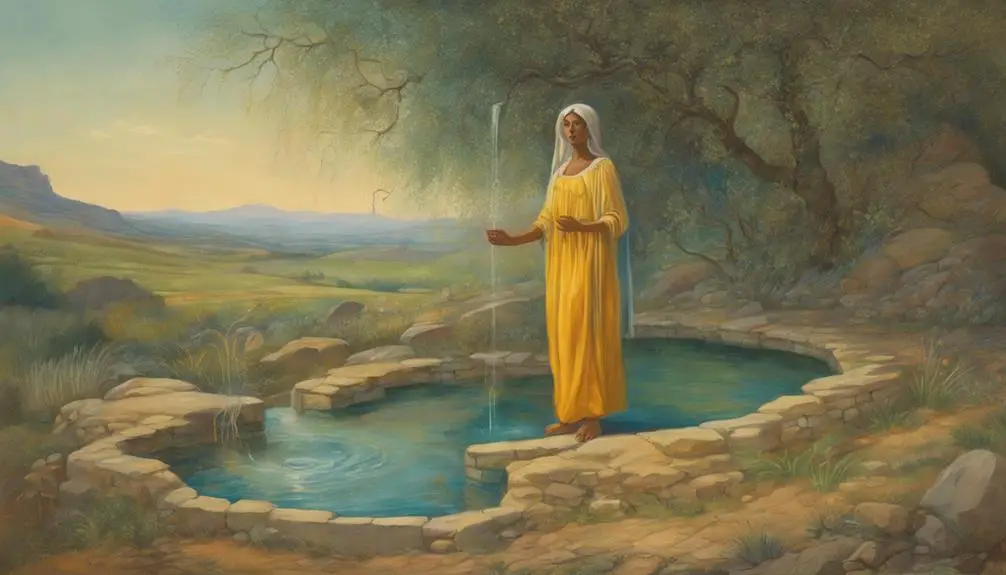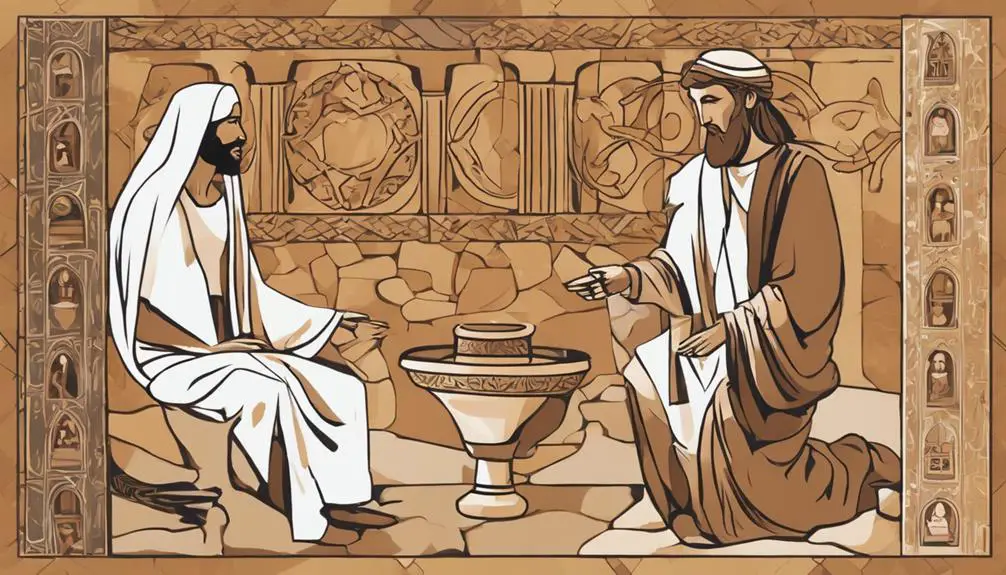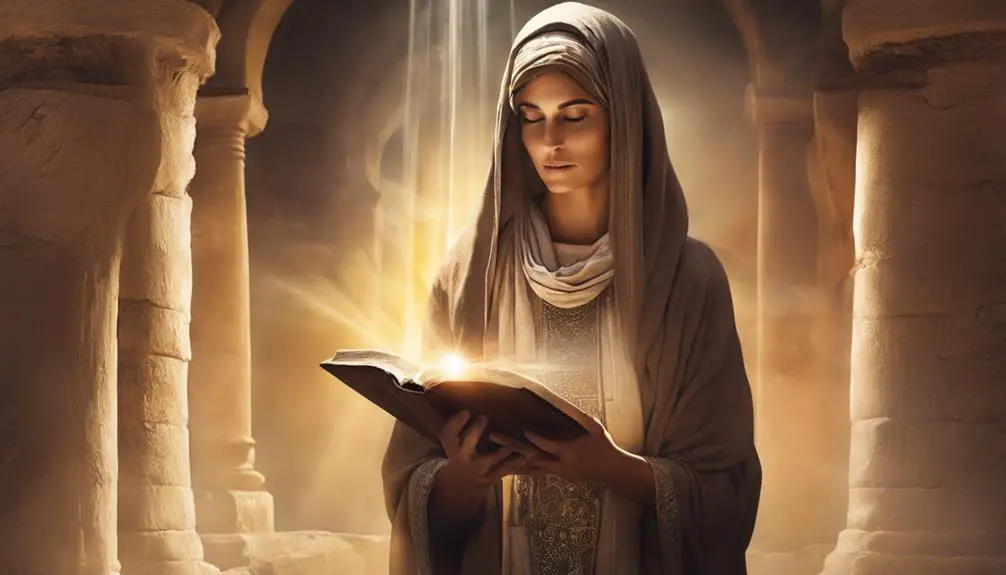Witness the untold influence of Photina, the Samaritan woman in the Bible, as we uncover her profound impact on early Christianity.

Photina in the Bible
Have you ever questioned the veracity of Photina's story in the Bible? She's often remembered as the Samaritan woman at the well who has a transformative encounter with Jesus. However, her story doesn't end there, and the impact she's had on early Christianity might surprise you.
What if I told you her influence extends far beyond what's written in the scriptures and that there's a lot more to uncover about this intriguing character?
Key Takeaways
- Photina was a Samaritan woman whose encounter with Jesus challenged and transformed her understanding of salvation.
- Through her interactions with Jesus, Photina transitioned from an outcast to a respected figure, highlighting the transformative power of faith.
- Saint Photina played a significant role in the development of early Christianity by spreading Jesus' teachings on forgiveness, redemption, and divine love.
- Despite facing persecution, Photina's courage, evangelistic work, and martyrdom left a lasting legacy on the Christian faith, inspiring many to remain steadfast in their beliefs.
Historical Background of Photina

Diving into the historical background of Photina, you discover her significant role in the New Testament, particularly in the Gospel of John where she's known as the Samaritan woman at the well. As the Bible doesn't provide much detail about Photina's lineage, you're left with scant information. However, she's identified as a Samaritan, an ethnic and religious group descended from ancient Semitic tribes residing in Samaria, a region situated between Galilee and Judea.
Analysing Photina's contemporaries, you find that she lived in a time when the Samaritans were despised by the Jews for their different religious beliefs and practices. They were considered heretics and were socially outcast, which might explain Photina's isolation at the well. Despite this, Photina is depicted as a woman of strength and courage, defying social norms by engaging in theological discussions with Jesus, a Jewish man.
Understanding Photina's historical context and her position within it provides depth to her character and emphasizes her significance in the New Testament. It's through her we get a glimpse of the complex social, religious, and ethnic dynamics of that time. Thus, Photina's story isn't just a biblical narrative, but also a historical account of that era.
Photina's Encounter With Jesus

Shifting our focus from her historical background, we now examine Photina's encounter with Jesus, a pivotal event that showcases her theological curiosity and marks a significant turning point in her life. During this interaction, Jesus breaks social norms, engaging in a theological conversation with a Samaritan woman, an act generally frowned upon in their culture.
Jesus' teachings during this encounter directly challenge Photina's understanding of the Samaritan culture and religion. He reveals that salvation isn't exclusive to the Jews but is also available to Samaritans, a profound revelation considering the prevailing cultural tensions and religious disparities between the two groups.
Photina's questions to Jesus reflect her inquisitiveness and thirst for knowledge. Her curiosity about the appropriate place to worship, for instance, provides Jesus with an opportunity to clarify that true worship transcends geographical boundaries and is about worshipping in spirit and truth.
This encounter's significance lies not only in Jesus' cross-cultural outreach but also in Photina's openness to new theological insights. Despite her initial skepticism, she's willing to listen, question, and internalize Jesus' teachings, indicating her spiritual maturity and readiness to embrace transformative truths.
Transformation of Photina

In the wake of her profound encounter with Jesus, Photina undergoes a remarkable transformation, one that significantly alters her perspective and role in her community. Her life, once defined by her circumstances, becomes a testament to the transformative power of faith.
There are three key aspects to this transformation:
- Personal Change: Photina goes from being an outcast to a beacon of hope. She's no longer a woman of ill repute but becomes highly respected due to her unwavering faith.
- Photina's Persecution: Despite the drastic improvements in her life, Photina faces significant persecution. Her newfound faith places her at odds with the societal norms of her time. However, she faces this persecution with remarkable courage and conviction, further solidifying her transformation.
- Photina's Family: Her faith profoundly impacts her family. Her children and sisters, inspired by her faith, become ardent followers of Jesus. This change not only reshapes her family's destiny but also influences the faith community around them.
In essence, Photina's transformation is a compelling example of how faith can drastically alter one's life and inspire others, even in the face of adversity.
Photina's Role in Early Christianity

Having considered Photina's transformation, let's now turn our attention to her influential role in the early Christian community, which was marked by her unswerving dedication to spreading the teachings of Jesus. Saint Photina, as she was later canonized, became synonymous with the early Christian mission of evangelism, fearlessly sharing her faith despite the prevailing cultural barriers.
Photina's teachings were rooted in the personal encounter she'd with Jesus. She used her experience to illuminate the spiritual truths of Jesus' message, focusing on themes of forgiveness, redemption, and divine love. Her teachings were a beacon of hope to many, carving a path for the acceptance and understanding of Jesus' teachings in a largely non-Christian society.
Significantly, Photina's role wasn't limited to teaching. She also exemplified the Christian ideals of love, humility, and service. This was reflected in her interaction with the community, her conduct and her commitment to the welfare of others. Thus, Saint Photina's teachings and life were instrumental in shaping the early Christian community. She became an embodiment of the Christian message she so passionately preached, leaving an indelible mark on the nascent Christian faith.
Legacy and Influence of Photina

The enduring legacy of Photina can be traced back to her significant contributions to the early Christian community and the profound influence she had on its evolution. As a Samaritan woman who became a follower of Jesus, she is remembered for her evangelistic work, especially in Carthage and Smyrna, and for the strength she demonstrated during her martyrdom.
Here are three key aspects of Photina's legacy:
- Photina's Martyrdom: This event marked a significant turning point in the early Christian community. Photina's steadfast faith despite severe persecution became a beacon of courage and resilience for other believers, inspiring them to stay firm in their faith.
- Influence on Early Christianity: Photina's evangelistic work played a critical role in spreading Christianity across regions, thus shaping the course of the religion.
- Photina's Family: Her family, too, played an instrumental role in the propagation of Christianity. Her children and sisters, who also accepted martyrdom, are venerated as saints in the Eastern Orthodox Church.
Frequently Asked Questions
What Are the Primary Sources for the Story of Photina in the Bible?
You're looking for primary sources for a particular story. Unfortunately, without context, it's unclear what story you're referring to. If you're asking about Photina's influence or legacy, it'd be helpful to know more.
However, for biblical stories, your primary sources would typically be religious texts and historical documents. Scholars also use oral traditions and archeology to provide context and additional details.
Are There Any Significant Differences in the Portrayal of Photina Across Different Versions of the Bible?
You're examining the portrayal of Photina across various Bible versions. You'll find no significant differences in Photina's depiction. Her influence remains consistent.
However, her presence isn't universally recognized due to divergent interpretations and Biblical accuracy. It's important to remember that the Bible's various versions can sometimes offer different perspectives or emphasis, but Photina's core narrative remains unchanged.
Are There Any Notable Artistic or Literary Representations of Photina Outside the Bible?
You're inquiring about Photina's influence outside of biblical texts. Yes, there are.
In historical context, she's depicted in various art forms such as paintings and sculptures. Moreover, literary references, particularly in early Christian writings and Orthodox tradition, often highlight her as a significant figure. Each representation may vary, reflecting different interpretations of her story and significance.
It's fascinating to see how her impact transcends the Bible itself.
What Are Some Modern Interpretations or Lessons Derived From Photina's Story?
You'll find modern interpretations of Photina's story highlighting her empowerment and influence. She's often portrayed as a symbol of resilience in the face of adversity. She also serves as a role model for evangelism, using her encounter to affect change in her community.
These interpretations showcase Photina's strength and courage, inspiring you to stand firm in your beliefs, even in challenging situations. Her story teaches lessons of faith, courage, and the power of influence.
How Does Photina's Story Compare or Contrast With Other Women Figures in the Bible?
You're examining Photina's influence in relation to other biblical women.
Unlike many, Photina directly converses with Jesus, showing assertiveness. This contrasts with the often passive roles of biblical women.
Yet, she shares their transformative encounters with the divine. Photina's story is a unique blend of assertiveness and transformation, making her an intriguing figure in the context of biblical feminism.
Differentiating her from others, yet also highlighting common threads in their experiences.
Conclusion
In conclusion, you've seen how Photina, a seemingly insignificant figure, had a profound encounter with Jesus. This encounter transformed her life, pushing her into a pivotal role in early Christianity.
Her legacy continues to resonate today, reminding us that even the most unlikely individuals can leave a lasting mark in history.
Photina's story is a testament to the enduring power of faith and the potential for redemption.



Sign up